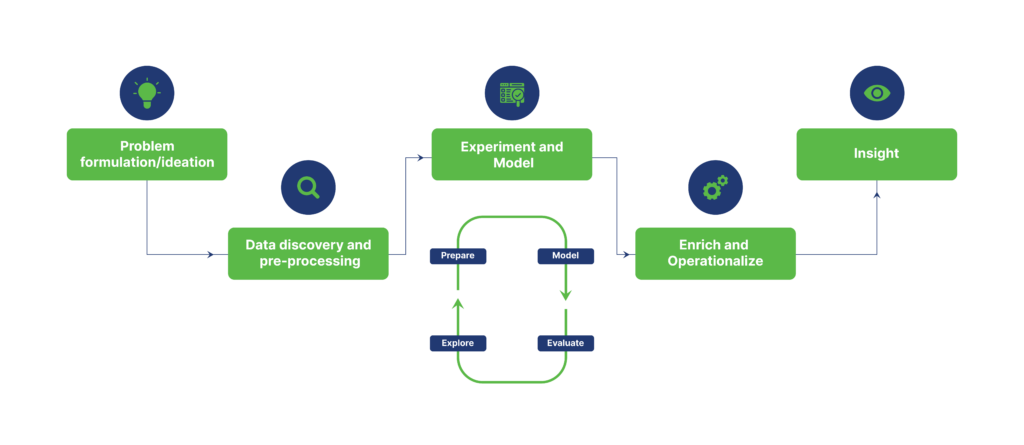
Data & AI Evangelist

Principal Data Architect
Subscribe to the newsletter
The growing volume of data from various sources has made data science a rapidly growing field across every industry. This interdisciplinary field uses algorithms, processes and procedures to examine large volumes of data and uncover patterns and insights for analysis and decision making. Consequently, it comes as no surprise that the demand for skilled data scientists is projected to surge by 36% between 2021 and 2031.
Microsoft Fabric, an end-to-end analytics service, provides data scientists with a versatile toolkit to perform various tasks in data analysis and machine learning. From data exploration, preparation, and cleansing to experimentation, modeling, and generating insights through BI reports, MS Fabric empowers users to efficiently manage data science workflows.
With Microsoft Fabric, businesses have a powerful platform at their disposal to make the most out of their data on a broader scale and gain valuable insights to drive informed decision-making.
With tools like Notebook, Data Wrangler, Power BI, and Visual Studio Code, Microsoft Fabric offers several opportunities for data scientists to assist organizations in solving complex problems, optimizing processes, and discovering new opportunities. Through this blog, let’s delve into the capabilities of data science within the Microsoft Fabric environment.
What is Data Science?
Data science involves extracting insights, patterns, and knowledge from different data sources (structured and unstructured) to analyze large data sets and derive actionable insights. Data science combines Machine Learning, Artificial Intelligence, advanced analytics, and specialized programming to discover hidden patterns and trends within data.
Since data science involves extracting valuable information from vast and complex data sets, it follows a specific lifecycle. This data science lifecycle outlines the five different stages involved in transforming raw data into actionable insights, including:
- Data collection
- Data preparation
- Exploration and visualization
- Experimentation and prediction
- Data communication

The Data Science experience within the Microsoft Fabric environment
In Microsoft Fabric, business users can access data science features to facilitate the completion of comprehensive data science workflows, serving the purposes of data enrichment and business intelligence. From conducting data exploration, preparation, and cleansing to engaging in experimentation, modeling, and delivering predictive insights within BI reports, users are equipped with a wide range of capabilities to make informed decisions and acquire the maximum potential of their data assets.
Microsoft Fabric users are granted access to a centralized hub known as the Data Science Home page, offering an array of valuable resources at their fingertips. This platform is designed for convenience and efficiency, allowing users to generate machine-learning Experiments, Models, and Notebooks with ease. Furthermore, users can import existing notebooks directly from this centralized location, saving them time and effort.
Getting started with Data Science within the Fabric environment: A step-by-step process
Within the Fabric environment, data scientists can efficiently manage data, notebooks, experiments, and models while easily accessing data from across the organization and collaborating with their fellow data professionals.

Ideally, data science process consists of the following stages:
- Problem formulation and ideation
- Data discovery and pre-processing
- Experimentation and modeling
- Enrich and operationalize
- Gain insights
Stage 1: Problem formulation and ideation
Microsoft Fabric streamlines the data science process by eliminating the need for separate platforms for different roles. Data scientists and data analysts work within the same ecosystem, enabling effortless data sharing and collaboration. Data science practitioners can easily share Power BI reports and datasets, significantly improving efficiency during the problem formulation stage.
Stage 2: Data discovery and pre-processing
Microsoft Fabric users can engage with data stored in OneLake through the Lakehouse feature. Lakehouse seamlessly integrates with Notebooks, allowing users to browse and interact with data effortlessly. Users can effortlessly import data from Lakehouse directly into a Pandas data frame, enabling smooth data exploration from OneLake.
Microsoft Fabric seamlessly integrates robust toolkit for data ingestion and orchestration pipelines, including data integration pipelines. With easy-to-create data pipelines, users can access and transform data into a format suitable for machine learning consumption.
- Data exploration
Understanding and visualizing data are essential elements of the machine learning process. Microsoft Fabric provides an array of tools tailored to explore and prepare data for analytical and machine learning purposes, depending on its storage location. Notebooks emerge as one of the most efficient avenues to initiate data exploration.
- Data preparation using Apache Spark and Python
Within Microsoft Fabric, users can transform, prepare, and delve into their data on a massive scale. Through Spark, users can utilize PySpark/Python, Scala, and SparkR/SparklyR tools for large-scale data preprocessing. Additionally, advanced open-source visualization libraries enrich the data exploration experience, enabling users to gain comprehensive insights from their data.
- Seamless data cleansing through data wrangler
A new feature has been introduced in the Microsoft Fabric Notebook interface. It allows users to utilize Data Wrangler, a coding tool, to streamline data preparation and automatically produce Python code. This enhancement streamlines the execution of time-consuming tasks, such as data cleansing, while promoting the creation of repeatable and automated processes through the generated code.
Stage 3: Experimentation and Machine Learning model
Notebooks equipped with tools such as PySpark/Python and SparklyR/R can manage the training of machine learning models. Machine learning algorithms and libraries play a pivotal role in model training. Library management tools facilitate the installation of these libraries and algorithms. This allows users to utilize various popular machine learning libraries to conduct model training within Microsoft Fabric.
Moreover, widely used libraries like Scikit Learn can also be utilized for model development. Tracking of Machine Learning model training is facilitated through MLflow experiments and runs. Also, Microsoft Fabric incorporates a built-in MLflow experience, enabling users to interact with it for logging experiments and models.
- Synapse ML
The SynapseML library, formerly recognized as MMLSpark, is an open-source resource developed and managed by Microsoft. It aims to streamline the creation of massively scalable machine learning pipelines. Moreover, as an integral component of the tool ecosystem, SynapseML extends the capabilities of the Apache Spark framework in various innovative directions.
By integrating multiple existing machine learning frameworks and novel Microsoft algorithms into a unified, scalable API, SynapseML offers a comprehensive solution. This open-source library comprises a diverse array of machine learning tools, facilitating the development of predictive models and the utilization of pre-trained AI models from Azure AI services.
Stage 4: Enrich and operationalize
Notebooks can conduct batch scoring for machine learning models using open-source libraries tailored for prediction tasks. Alternatively, users may choose to employ the Microsoft Fabric scalable universal Spark Predict function, which supports MLflow packaged models accessible in the Microsoft Fabric model registry.
Stage 5: Gain insights
In Microsoft Fabric, users can effortlessly write values into OneLake and seamlessly incorporate them into Power BI reports using the Power BI Direct Lake mode. This simplifies the process for data science practitioners to communicate their findings to stakeholders while streamlining operational processes.
Exploring data with semantic link (preview) functionality
Data scientists and business analysts often dedicate extensive effort to understanding, cleansing, and transforming data before initiating any meaningful analysis. Business analysts commonly rely on semantic models to encode their domain knowledge and business rules into Power BI measures. However, data scientists typically use the same dataset in a different coding environment or language.
Through the Semantic link (preview), data scientists gain the ability to link Power BI semantic models with the Synapse Data Science experience in Microsoft Fabric using the SemPy Python library. SemPy streamlines data analysis by capturing and utilizing data semantics while users execute diverse transformations on the semantic models. Leveraging the semantic link empowers data scientists to:
- Eliminate the requirement to rewrite business logic and domain knowledge within their code
- Readily access and utilize power BI measures within their code
- Leverage semantics to empower new capabilities, like semantic functions
- Analyze and validate functional dependencies and relationships among data
By incorporating SemPy, organizations can foresee:
- Boosted productivity and faster collaboration among teams that operate on the same datasets
- Enhanced cross-collaboration between business intelligence and AI teams
- Reduced ambiguity and an easier learning curve when onboarding onto a new model or dataset
- Leverage the capabilities of Microsoft Fabric with Confiz
Leverage Microsoft Fabric capabilities for real-time analytics with Confiz
Data science is an indispensable component in Microsoft Fabric, offering opportunities to uncover valuable insights, optimize processes and drive innovation.
Microsoft Fabric streamlines your organization’s data and analytics workloads, enabling you to extract valuable insights and drive business value from your data. To harness the full potential of Fabric and leverage your data assets to build transformative and secure analytical solutions at enterprise scale, reach out to us at marketing@confiz.com. Benefit from our expertise in Microsoft Fabric implementation, data science solutions, and maximizing the value of your data. Let us empower your organization’s data-driven success.



